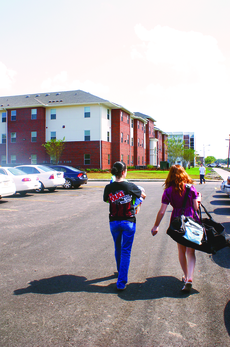With three new residence halls and additional housing options, more students are opting for on-campus residency this year. Housing applications for the 2008 fall semester have increased by more than 165 applicants since the 2007 fall semester, Eugene Dial, vice president of student affairs and enrollment services, said.
“The cost of driving back and forth is so costly it is cost efficient to live on campus. When students look at the cost of fuel and time spent – students could be working, making money during this time – it just makes more economic sense,” Dial said.
The rising cost of fuel isn’t the only believed reason for the increase in on-campus residents.
“The new facilities will provide students with state-of-the-art amenities and privacy. It makes students want to live here,” Dial said.
“The increase in students interested in living on campus is a nice development. More campus residents means a more active campus life. The increase in housing requests necessitated bringing Babington Hall back on line. As a result we will be hiring some additional resident assistants for both Babington and a couple of other halls. We don’t anticipate any particular difficulties with the increase in residents once we have reached a full staff,” Lisa Grubbs, director of Residential Life, said.
But with the excitement of new facilities and additional on-campus residents, comes various problems.
“The development of the new halls is behind schedule by a couple of weeks; the halls should have been finished in early July, early August at latest. Everything will be very hectic,” Kim Montague, director of housing, said. “No one is to blame for the setback. We can’t open new halls two weeks or four days before school starts without having difficulties. We need to check light bulbs, air conditioners, we need a few months to walk through the new buildings and check everything out.”
Brittany Taraba, marketing junior from Monroe, who lives in Scholars Hall, does not have a functioning room key and will be without one for over a week.
“None of the dorms are 100 percent, completely finished with,” Taraba said. “My roommate and I actually trust each other, so it isn’t really a big problem, but I would like to have my key. Painting is still being done, elevators are being worked on, little details are still being worked out.”
Montague assures that any commitments made to students will be followed through.
“It appears we may be a bit understaffed right now. Our staff is swamped; everyone is trying to catch up. Once we have a routine, I think we will be ok,” Montague said. “We will try our best to be on top of maintenance. I have heard horror stories about poor campus maintenance; prevention on a periodic basis is our plan right now. If not, the buildings will deteriorate very quickly.”
Another problem that may be a concern to students and faculty is parking.
“It will take a while for people to get used to the new layouts on campus because in different parts of campus, parking will be different. The lot behind the tennis courts will be for commuters and residents, and the lot next to the library will be for commuters. But, overall parking should not be a problem because parking spots will actually be freed,” Dial said.
Both Dial and Montague agree the increase in students on campus will boost participation in campus events and student involvement.
“Many more students will be on campus and will be able to participate and be ‘in the know’ about activities. Definitely a positive impact for the university,” Dial said.








